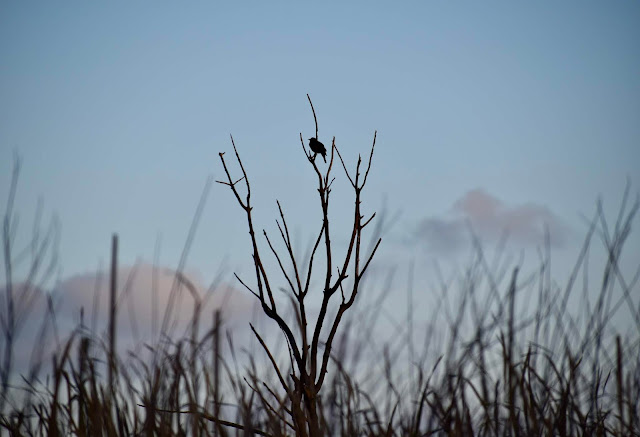eBird Project: Final Thoughts
 |
| Red-winged Blackbird (Agelaius phoeniceus) in IL Beach State Park South Unit, Oct. 29, 2019 |
eBird was created in 2002 for birdwatchers to share and access information, but the program has turned into something much bigger. It's now one the largest bird data sharing platforms in the world with virtually unlimited potential in terms of application and use. I feel that eBird's variety of features and ways to access the data are proof that it's geared towards the general public and scientists alike. Point counts and transects pulled from species distribution and abundance data allow for user-friendly area and species searches on eBird site. At the same time, data can be downloaded in various formats and filters for use by professionals. A recreational birdwatcher might look up a specific location or species to plan their next birding experience. A scientist might download data to study population trends of a specific species, like this study for which used eBird data was used to analyze the range expansion of Calypte anna, the Anna's Hummingbird. The eBird program is also proving to be invaluable tool for conservationists who rely on real-time data for species assessments, habitat management, and in their efforts to inform related policy. I expect the use of eBird data will become increasingly common in the field of conservation in the years to come. If I were involved in conservation, I would certainly refer to eBird data for my efforts.
The fact that there is no formal training or education level required for participation has been key to the success of eBird. It would not have collected as much data or be nearly as useful in research, education, and conservation as it is today if not for this inclusivity. However, the inclusivity is also the most problematic aspect of this program. Not all data is vetted by experts; if a species does not trigger an alert, it's generally accepted into the data pool. This may not be a major issue for casual users, but it's an important consideration for academic or research-based use. Indeed, the interactive maps, bar charts, and graphs on the eBird site likely reflect the non-expert, human error and may not be entirely useful to professionals. However, scientists could get around this by only integrating data that can be confirmed with audio and/or visual media. The fact that others can flag inaccurate observations is a great feature, but it would be ideal if Cornell Lab could figure out a way to further reduce the inaccuracies. Perhaps they could start by requiring media evidence for all observations made my inexperienced users. It might not be impossible to manually sift through all of the reports, but eBird managers could explore the potential uses of automated photo or audio recognition.
Although the goal of public engagement is evident in this program, I believe public outreach could be improved upon. Before starting this project, I had only heard about eBird in passing. I really didn't know anything about it until I started digging in over the past few weeks. That said, I think there's a missed opportunity here. Advertising on related websites (those with a conservation or educational focus, or even websites for companies that provide gear for outdoor activities) would increase awareness of the project. Conservation-based organizations could promote eBird in their localities. State natural resource departments could advertise eBird on their sites and incorporate it in their existing methods of public outreach. Local jurisdictions could encourage community involvement and advertise birdwatching (and eBird) as a local activity. Travel review sites could even be involved to encourage eBirding at hotspot destinations (and those for which data is lacking). Photographers could be appealed to with seasonal competitions. National, state, and local parks could establish avicaching programs. The possibilities to increase participation are endless, but it appears public outreach is currently based on word of mouth or existing connections to the birding world.
If I were in charge of eBird, I would first explore the ways in which we could limit data inaccuracies. The submission process is already so easy that I doubt a couple extra steps would deter participation. If this means requiring a familiarization tutorial based on regional species or requiring new users to include media for a period of time, I think it's worth it to ensure integrity of the data. I would also make sure to highlight the "user-review" feature of the site. There is a large base of eBirders that may not be aware that they too can review others' submissions for accuracy. I only learned about it from my communication with a regional reviewer the other day. My second focus would be ramp up the public outreach to increase participation and ultimately, available data. But it's more than just collecting data for the sake of science - it's about increasing the public's awareness and concern for avian species. The more people there are observing and learning about birds, the more collective motivation there is to protect them.
Resources
- Cornell Lab of Ornithology, & Audubon. (2019). What is eBird? Retrieved from https://help.ebird.org/customer/en/portal/articles/973841-what-is-ebird-.
Comments
Post a Comment